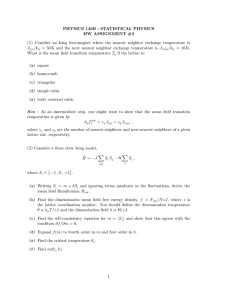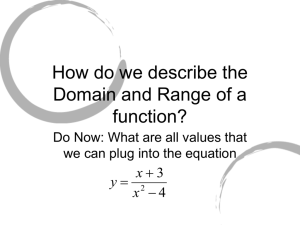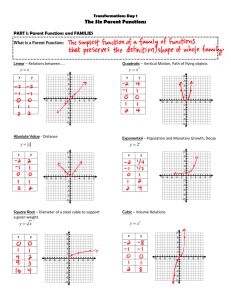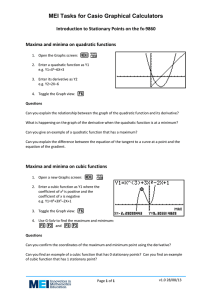(1)
advertisement
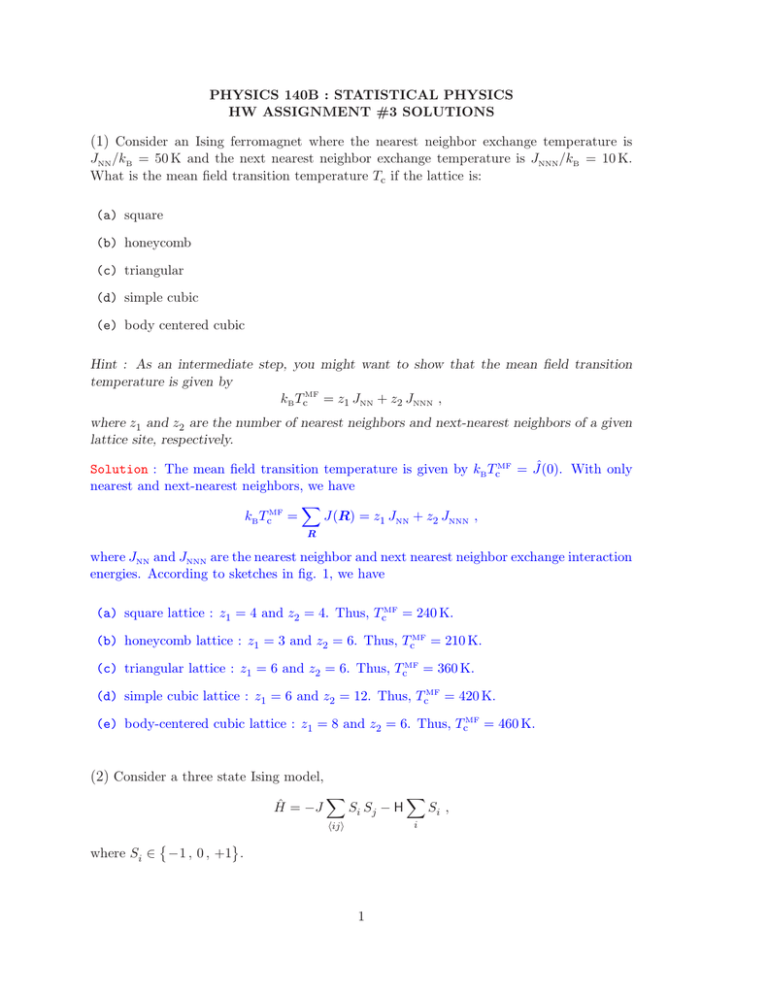
PHYSICS 140B : STATISTICAL PHYSICS
HW ASSIGNMENT #3 SOLUTIONS
(1) Consider an Ising ferromagnet where the nearest neighbor exchange temperature is
JNN /kB = 50 K and the next nearest neighbor exchange temperature is JNNN /kB = 10 K.
What is the mean field transition temperature Tc if the lattice is:
(a) square
(b) honeycomb
(c) triangular
(d) simple cubic
(e) body centered cubic
Hint : As an intermediate step, you might want to show that the mean field transition
temperature is given by
kB TcMF = z1 JNN + z2 JNNN ,
where z1 and z2 are the number of nearest neighbors and next-nearest neighbors of a given
lattice site, respectively.
ˆ
With only
Solution : The mean field transition temperature is given by kB TcMF = J(0).
nearest and next-nearest neighbors, we have
X
kB TcMF =
J(R) = z1 JNN + z2 JNNN ,
R
where JNN and JNNN are the nearest neighbor and next nearest neighbor exchange interaction
energies. According to sketches in fig. 1, we have
(a) square lattice : z1 = 4 and z2 = 4. Thus, TcMF = 240 K.
(b) honeycomb lattice : z1 = 3 and z2 = 6. Thus, TcMF = 210 K.
(c) triangular lattice : z1 = 6 and z2 = 6. Thus, TcMF = 360 K.
(d) simple cubic lattice : z1 = 6 and z2 = 12. Thus, TcMF = 420 K.
(e) body-centered cubic lattice : z1 = 8 and z2 = 6. Thus, TcMF = 460 K.
(2) Consider a three state Ising model,
Ĥ = −J
X
Si Sj − H
X
i
hiji
where Si ∈ −1 , 0 , +1 .
1
Si ,
Figure 1: Nearest neighbors (red circles), next nearest neighbors (light blue squares), and
some third nearest neighbors (green triangles) for five common lattices. (a) square, (b)
honeycomb, (c) triangular, (d) simple cubic, and (e) body centered cubic.
(a) Writing Si = m + δSi and ignoring terms quadratic in the fluctuations, derive the
mean field Hamiltonian HMF .
Solution : We have
Si Sj = (m + δSi )(m + δSj )
= m2 + m (δSi + δSj ) + δSi δSj
= −m2 + m (Si + Sj ) + δSi δSj .
We ignore the fluctuation term, resulting in the mean field Hamiltonian
X
Si .
HMF = 12 N zJm2 − zJm + H
i
(b) Find the dimensionless mean field free energy density, f = FMF /N zJ, where z is
the lattice coordination number. You should define the dimensionless temperature
θ ≡ kB T /zJ and the dimensionless field h ≡ H/zJ.
Solution : The effective field is Heff = zJm + H. Note that
X
zJm + H
Heff S/kB T
.
e
= 1 + 2 cosh
kB T
S
2
It is convenient to adimensionalize, writing f = /N zJ, θ = kB T /zJ, and h = H/zJ.
Then we have
!
m
+
h
.
f (m, θ, h) = 21 m2 − θ ln 1 + 2 cosh
θ
(c) Find the self-consistency equation for m = hSi i and show that this agrees with the
condition ∂f /∂m = 0.
Solution : Extremizing the free energy f (m) with respect to m, we obtain the mean
field equation:
2 sinh m+h
∂f
θ
.
=0
=⇒
m=
∂m
1 + 2 cosh m+h
θ
The self consistency condition is the same:
P
2 sinh m+h
S e(m+h)S/θ
θ
S
.
m = P (m+h)S/θ =
1 + 2 cosh m+h
Se
θ
(d) Expand f (m) to fourth order in m and first order in h.
Solution : We have
(h + m)2 (h + m)4
1 2
+
+ ...
f (m) = 2 m − θ ln 3 +
θ2
12θ 4
m4
2hm
2 2
m +
−
+ ... .
= −θ ln 3 + 12 1 −
3
3θ
36θ
3θ
(e) Find the critical temperature θc .
Solution : The critical temperature is identified as the value of θ where the coefficient
of the m2 term in the free energy vanishes. Thus, θc = 23 .
(f) Find m(θc , h).
Solution : Setting θ = θc = 23 , we extremize f (m) and obtain the equation
f ′ (m, θc , h) = 0 =
2h
m3
−
9θc3 3θc
=⇒
1/3
=
m(θc , h) = 6 θc2 h
(3) For the O(3) Heisenberg ferromagnet,
Ĥ = −J
X
hiji
3
Ω̂i · Ω̂j ,
1/3
8
h
3
.
find the mean field transition temperature TcMF . Here, each Ω̂i is a three-dimensional unit
vector, which can be parameterized using the usual polar and azimuthal angles:
Ω̂i = sin θi cos φi , sin θi sin φi , cos θi .
The thermodynamic trace is defined as
Z Y
N
dΩi
Tr A(Ω̂1 , . . . , Ω̂N ) =
A(Ω̂1 , . . . , Ω̂N ) ,
4π
i=1
where
dΩi = sin θi dθi dφi .
Hint : Your mean field Ansatz will look like Ω̂i = m + δΩi , where m = hΩi i. You’ll want
to ignore terms in the Hamiltonian which are quadratic in fluctuations, i.e. δΩi · δΩj . You
can, without loss of generality, assume m to lie in the ẑ direction.
Solution : Writing Ω̂i = m + δΩi and neglecting the fluctuations, we arrive at the mean
field Hamiltonian
X
HMF = 12 N zJm2 − zJm ·
Ω̂i ,
i
where m = hΩ̂i i is assumed to be independent of the site index i. The partition function is
Z=
1
2
e− 2 N βzJm
Z
dΩ βzJm·Ω̂
e
4π
!N
.
We once again adimensionalize, writing f = F/N zJ and θ = kB T /zJ. We then find
Z
dΩ m·Ω̂/θ
2
1
f (m, θ) = 2 m − θ ln
e
4π
sinh(m/θ)
1 2
= 2 m − θ ln
m/θ
m2
m4
1 2
= 2 m − θ ln 1 + 2 +
+ ...
6θ
120 θ 4
m4
1 2
m +
+ ... .
= 12 1 −
3θ
180 θ 3
Setting the coefficient of the quadratic term to zero, we obtain θc = 13 .
(4) A system is described by the Hamiltonian
Ĥ = −J
X
I(µi , µj ) − H
X
δµi ,A ,
i
hiji
where on each site i there are four possible choices for µi : µi ∈ {A, B, C, D}. The interaction
matrix I(µ, µ′ ) is given in the following table:
4
I
A
B
C
D
A
+1
−1
−1
0
B
−1
+1
0
−1
C
−1
0
+1
−1
̺N (µ1 , . . . , µN ) =
N
Y
̺(µi )
D
0
−1
−1
+1
(a) Write a trial density matrix
i=1
̺(µ) = x δµ,A + y (δµ,B + δµ,C + δµ,D ) .
What is the relationship between x and y? Henceforth use this relationship to eliminate y in terms of x.
Solution : The density matrix ̺ must be normalized, hence
Tr ̺ = x + 3y ≡ 1
y = 13 (1 − x) .
=⇒
(b) What is the variational energy per site, E(x)/N ?
Solution : The energy per site is
E
= − 12 zJ Tr ̺(µ) ̺(µ′ ) I(µ, µ′ ) − H Tr ̺(µ) δµ,A
N
o
n
= − 21 zJ x2 + 3y 2 − 4xy − 4y 2 − H x
= − 21 zJ x2 + 13 (1 − x)2 − 43 x(1 − x) − 94 (1 − x)2 − H x
2
1
= 18 zJ 1 + 10 x − 20 x − H x .
(c) What is the variational entropy per site, S(x)/N ?
Solution : The entropy per site is
S
= −kB T Tr ̺ ln ̺
N
= −kB x ln x + 3 y ln y
(
= −kB
1−x
x ln x + (1 − x) ln
3
5
)
.
(d) What is the mean field equation for x?
Solution : The free energy per site is
E − TS
N zJ
(
)
1−x
2
1
,
= 18 1 + 10 x − 20 x − hx + θ x ln x + (1 − x) ln
3
f≡
where h = H/zJ and θ = kB T /zJ are the dimensionless field and temperature, respectively. The mean field equation is obtained by extremizing f (x, θ, h):
∂f
3x
5
= 0 = 9 (1 − 4x) − h + θ ln
.
∂x
1−x
(e) What value x∗ does x take when the system is disordered?
Solution : Clearly x = y = 14 in the disordered phase, since each state is then equally
probable. The global symmetry of the problem, which is Z4 , is then unbroken.
(f) Write x = x∗ + 34 ε and expand the free energy to fourth order in ε. The factor 34 should
generate manageable coefficients in the Taylor series expansion. You may want to use
a symbolic manipulator like Mathematica here.
Solution : We write x = 14 + 34 ε, in which case
3x
5
f = 9 (1 − 4x) − h + θ ln
1−x
2
3
5
3
ε − θ ε3 + 74 θ ε4 + O(ε5 ) .
= −θ ln 4 − 4 hε + 2 θ − 12
(g) Sketch ε as a function of T for H = 0 and find Tc . Is the transition first order or
second order?
Solution : The transition in zero field is first order, but you’d have had to read
ahead a little in the notes to understand this. The point is that whenever a Landau
expansion of the free energy has a cubic term, e.g. for
f (ε) = f0 + 12 a ε2 −
1
3
u ε3 + 14 b ε4 + . . . ,
the second order transition we would expect occurs at a = 0 is preempted by a first
order transition that occurs at some positive value of a, i.e. before the curvature at
ε = 0 goes negative. To see this, we differentiate, obtaining
f ′ (ε) = 0 = a − u ε + b ε2 ε .
The first order transition occurs when the local minimum of f (ε) at ε > 0 crosses the
value f (0). Thus, in addition to the mean field equation above, we have the condition
f (ε) = f (0)
1
2
=⇒
6
a ε2 −
1
3
u ε3 + 14 b ε4 = 0 .
Figure 2: Order parameter versus temperature for a free energy f = 21 a ε2 − 31 u ε3 + 14 b ε4 .
When b > 0, the usual second order transition at a(θ ∗ ) = 0 is preempted by a first order
transition at a(θc ) = 2u2 /9b. The cubic term stabilizes the ordered phase for temperatures
between θ ∗ and θc . The dashed curve is what ε(θ) would resemble in the absence of the
cubic term, i.e. when u = 0.
Thus, we have the following two quadratic equations to solve simultaneously:
a − u ε + b ε2 = 0
1
2
a − 13 u ε + 14 b ε2 = 0 .
Eliminating the quadratic term, we obtain ε = 3a/u at the first order transition, and
inserting this into either of the above equations
we obtain the relation u2 = 29 ab. For
5
our specific model, we have a = 3 θ − 12 , u = 3θ, and b = 7θ. Thus, the first order
transition occurs at a critical temperature
θc =
35
76
.
Note that the sign of the quadratic term in f (ε) is still positive at this point, and
5
. If there were no cubic term, we would exremains so down to a temperature θ ∗ = 12
pect a second order transition at this latter temperature, but as we see it is preempted
by the first order transition.
7

